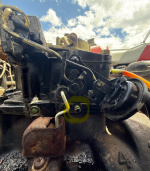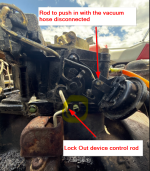MrHProblems
Seaman Apprentice
- Joined
- Jun 2, 2025
- Messages
- 34
I recently acquired this 1986 Four Winns Horizon 190 with a Mercruiser 230 V8 in it.
The motor runs and sounds good at idle but it feels underpowered, only goes up to 3,000 rpms and 30mph at WOT under load.
I noticed the throttle plates/butterflies don't open at all when I move the throttle. I disconnected the throttle cable so I would have full range of throttle abilities and they don't open that way either. I can use my finger and easily move them fully vertical though.
Here is a pic from what I believe is the throttle shaft(circled) with nothing connected to it.
I cant find a diagram that makes any sense online for what I am missing here.
*Crossposted*
The motor runs and sounds good at idle but it feels underpowered, only goes up to 3,000 rpms and 30mph at WOT under load.
I noticed the throttle plates/butterflies don't open at all when I move the throttle. I disconnected the throttle cable so I would have full range of throttle abilities and they don't open that way either. I can use my finger and easily move them fully vertical though.
Here is a pic from what I believe is the throttle shaft(circled) with nothing connected to it.
I cant find a diagram that makes any sense online for what I am missing here.
*Crossposted*























